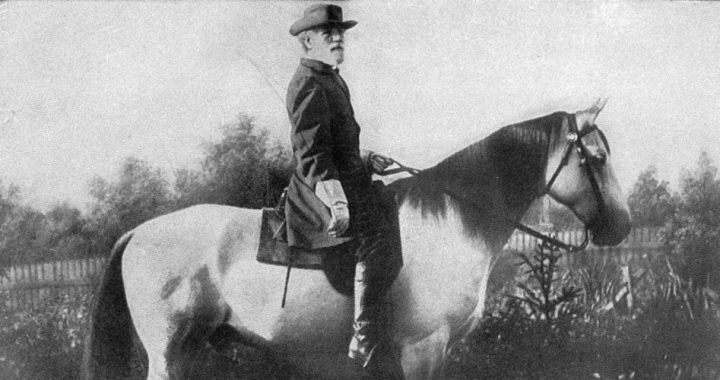
After the tragic events in Charlottesville, Virginia, precipitated by the city government’s decision to remove the statue of Confederate Robert E. Lee from Emancipation Park, we should be struck by how the animosity toward Lee is based on ignorance of the man and his cause.
The case against honoring Lee seems to be that the Civil War was fought to abolish slavery, and since General Lee (shown) was the most important military leader of the side that supposedly was fighting to “keep slavery,” no monuments should remain honoring his memory — even in his home state of Virginia.
Slavery was certainly a source of friction between the northern and southern sections of the country, contributing to the decision of seven southern states — Alabama, Georgia, Florida, South Carolina, Mississippi, Louisiana, and Texas — to secede from the Union. But one must also look at other factors as well, such as the tariff, which tended to help the economy of the industrialized North at the expense of the mostly agrarian South. In fact, it had almost caused the secession of South Carolina a generation earlier.
And secession was not just a “Southern idea.” Northern states, more than once, had threatened secession earlier in U.S. history, largely due to their resentment at the outsized influence of Virginia in the Union.
After seven states left the Union in late 1860 and early 1861, eight states where slavery remained a legal institution were still in the Union. If the war had been fought to abolish slavery, one wonders why President Abraham Lincoln did not call for an invasion of those eight states, as well.
One of the states that had not seceded was Virginia, where slavery was on the decline, and was expected to eventually go away as it had in the northern states, when it was no longer economically viable. Before Lincoln’s call for 75,000 volunteers to “suppress the rebellion” in the South, Virginia had no intention of leaving the Union. But once faced with a decision of either invading fellow states or joining the seceded states, Virginia reluctantly seceded, as well.
General Lee lamented that he could not draw his sword against his home state of Virginia, and thus tendered his resignation from the U.S. Army. He was soon offered a general’s commission in the army of the Confederate States.
In short, Virginia’s secession had nothing to do with slavery, and Lee’s decision to leave the U.S. Army was because he could not bear to fight against his home state.
It had nothing to do with protecting slavery, which he detested.
He had inherited slaves; however, he freed them. In an 1856 letter, Lee wrote of his hope that slavery would eventually disappear,” declaring, “There are few, I believe, in this enlightened age, who will not acknowledge that slavery as an institution is a moral and political evil. He called for prayer to see the “final abolition of human slavery” through peaceful means.
Writing in the Confederate Veteran of August 1905, Col. T.L. Broun of Charleston, West Virginia, recalled having been present at St. Paul’s Church in Richmond, Virginia, in June 1865. “It was communion day; and when the minister was ready to administer the holy communion, a negro in the church arose and advanced to the communion table. He was tall, well-dressed, and black. This was a great surprise and shock to the communicants and others present. Its effect upon the communicants was startling, and for several moments they retained their seats in solemn silence and did not move, being deeply chagrined at this attempt to inaugurate the ‘new regime’ to offend and humiliate them during their most devoted Church services. Dr. Minnegerode [the minister, although his name was evidently misspelled] was evidently embarrassed.”
Broun continued: “General Robert E. Lee was present, and ignoring the action and presence of the negro, arose in his usual dignified and self-possessed manner, walked up the aisle to the chancel rail, and reverently knelt down to partake of the communion, and not far from the negro. This lofty conception of duty by Gen. Lee under such provoking and irritating circumstances had a magic effect upon the other communicants (including the writer), who went forward to the communion table.”
“By this action of Gen. Lee,” Broun concluded, “the services were conducted as if the negro had not been present. It was a grand exhibition of superiority shown by a true Christian and great soldier under the most trying and offensive circumstances.”
Besmirching the memory of General Lee by attacking him as a slave-owning racist who led a bloody rebellion to preserve slavery that cost well over 600,000 American lives is despicable. Edward Smith, director of American Studies at American University in Washington, D.C, and the co-director of The Civil War Institute (who contends that the above story is absolutely true), wrote in National Geographic News on September 7, 2001, “Today, and deservingly so, Lee is honored throughout the country.”
Unfortunately, Smith continued, “there are many Southerners who claim to cherish Lee and revere the flag for which he so nobly fought but still harbor rabidly racist sentiments toward blacks and their long delayed social progress. Such people do not honor Lee; instead they disgrace him.”
And such historical ignorance has contributed to the movement to tear down monuments to the great man — even if it leads to violent confrontations, as in Charlottesville, Virginia.



